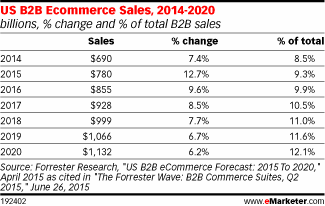How to market, launch and grow your B2B business abroad
British exports figures continue to show sharp growth - despite the concerns about Brexit. With a £30bn opportunity for UK businesses every single month, how should you go about it? Graham O'Rourke, CEO of eCommerce and mobile apps platform developer Aphix Software, goes through the opportunities and obstacles facing export-ambitious businesses
1. B2B Exports Strategy - The Foundations
Let's face it - we've all made mistakes rushing into marketing initiatives without any proper planning. And what happens? The results are erratic at best. In some cases, results are not even measured. Those in glasshouses should not throw stones, so neither will I!
However, learning from those mistakes is important, especially when looking to new markets. So the very first thing you need before starting any marketing initiative: a strategy. What do I mean by that Fundamentally, I mean it's necessary to challenge your assumptions and ask yourself a few questions.
Questions such as:
Who is the customer?
You may feel you know this already from your existing customers, but have you researched and talked to"sweet spot" customers in new markets? Are they the same profile of customer as those in the UK? Are they the same size? Do they have the same challenges, or additional ones? What it is different about them?
Having a clear view of that "sweet spot" customer is key for an export growth strategy.
What is the market structure?
Assuming the market is the same is a common mistake. Often the supply chain, how customers buy, who they buy from and who they trust to help them is subtly yet importantly different from market to market - even those markets close by.
Talking to similar (but non-competing!) companies that have successfully entered that overseas market can reap great results.
Recently at Aphix, we were investigating the Spanish market with a view to a large market launch there - but having canvassed some opinions from similar companies who had made great progress in Spain, we made a decision not to go ahead with our plans for a large launch - instead we are focussed on selling via channel partners. The advice of peers was so valuable to us in coming to this decision, and probably saved us a world of headaches further down the line.
Do you know the culture?
Let me tell you a quick story about culture and communication that really brought this home to me.
A friend of mine has a company that sells heating controls to utility companies in the UK. Things were going well, the company were thinking about expansion plans and it was decided to pitch for investment in the US.
He felt the pitch had gone well, but afterwards one potential investor held up his hand and asked a question, "What is a hot water heater controller?"!
Of course, if he had pitched air conditioning or temperature control in the US, his pitch would have been more successful. It was a case of same product, different angle.
Understanding cultural differences like this (and there are many of them) will allow you to ensure product-market fit is adjusted to best position your product for success in that new market.
2. The global B2B opportunity
But what new markets are really available for B2B? Well, all available data shows all trends moving in the same direction - that growth for B2B exports is going to continue at a rapid pace in the coming years.
In the UK specifically, recent growth has been phenomenal - regardless of any concerns around Brexit. Latest figures show that for May 2017, total trade exports were £29.4bn - a staggering 25% (or £5.9bn) increase year-on-year.
And that was no single month anomaly. In total for Q1 2017, exports were up 23% compared to Q1 2016, and the opportunity is open to allB2B companies, both large and small.
There is little doubt that eCommerce is set to play a major role in this B2B export growth, and in many cases already is.

A major study by Forrester in 2015 predicted that by 2020 in the US alone, B2B eCommerce will top $1.1 trillion and account for more than 12% - or one in eight dollars spent in B2B. To put that in perspective, it would be a rise of 64% in just six years - up from $690bn in 2014.
Worldwide, the same study showed that global B2B eCommerce will be worth close to $7 trillion by 2020, meaning the global B2B market will be worth more than double the entire B2C eCommerce market.
3. The digital opportunity for B2B exports
So that's the size of the opportunity, but what, specifically, should B2B companies keen to export be paying attention to?
Customer, culture and market structure have always been nuts to crack for companies keen to break into new markets. What is different in recent years is the massive technological and communications breakthroughs of the web, and digital marketing presents both massive opportunities and massive challenges for companies keen on export growth.
When employing online marketing it is crucial that you have a strategy that suits both you as a company but also (and even more importantly) that suits how your customer likes to buy.
From a B2B exports point of view that may be any of a host of things.
Prospect communications
For one example, more information could be required before they agree to a demo or meeting. For another, multiple people in the company might need to be involved in the sales conversation.
Having the resources in place to manage this is key. Prospects need a rapid and informed response. They may seek clarification, require follow-up emails and telephone communications. They may live on other channels like LinkedIn or Twitter. Live chat could be something that they not only prefer, but expect.
A systematic approach to lead generation
It is also important to have systems in place. How do you capture these leads? What is the lead source (Organic search, Google, Bing, Facebook, etc) and what did they search for?
I think in the early days of digital lead generation that last question is key: what did converting customers search for? If you can keep sales & marketing working closely together with that type of tight feedback you will continue to refine and improve your success online.
4. Other B2B export factors to consider
Having a base
As a B2B company I believe that when you are committed to a country you should be there. The only question is: When?
So I would always advocate that the CEO or Head of Sales is directly involved in the initial market research and that must include being in the country for a period, especially if your price point and margin allow it.
This approach is, I believe, essential to understanding the market structure, competition and cultural differences. It also allows you to build a personal rapport with your first customers or partners. It is these reference customers that will help you accelerate your early growth.
Trade shows
This might be a slightly controversial view, but I believe trade shows are mostly a vanity exercise. They may be a necessary evil but rarely, in my experience, do they deliver sufficient sales to justify them.
This is a matter that divides people right down the middle, as some businesses will swear blind that a significant proportion of their annual sales rely on trade shows. And that too is probably true: for some businesses trade shows are essential. However, there are some common mistakes that first-time exhibitors make across the board.
These include:
- choosing the wrong trade show
- underestimating the investment
- assuming that sales are made at shows
- being lured into taking a stand at a show where your customers are exhibiting ... the people coming through the doors are then their customers, not yours!
Once you get that right, and understand that the exhibition/entry costs are a small fraction of the real costs that importantly include a lot of your valuable sales and marketing team's time, and importantly, sales are made before and after the show - not at it.
Note: This post originated as an interview for UK financial services Lombard. You can read the interview on the Lombard ContentLive website here.
A short bio on Aphix Software
Aphix Software develops and supports the world’s most flexible digital ordering platform for wholesalers & e-tailers across the UK and Europe. We have offices in London, Dublin & Madrid and currently employ 16 people.
Aphix Software helps wholesalers “Sell Smarter” by significantly reducing order processing costs, growing online revenues and enhancing their customer service. We do this by connecting complex business systems in real time to our specialist & secure cloud platform with speed and ease.
For more on the products and features available within the Aphix cloud platform, check out our pages on B2B and wholesale e-commerce suite and mobile apps suite for B2B field sales reps.





